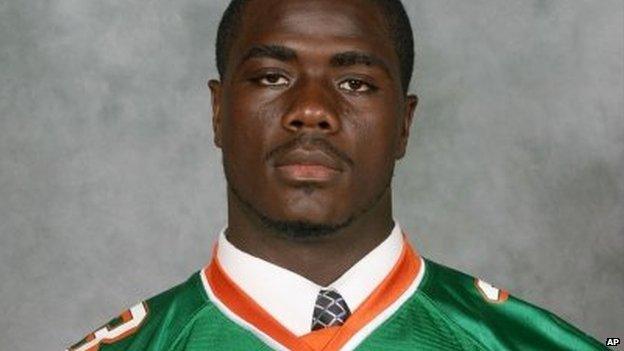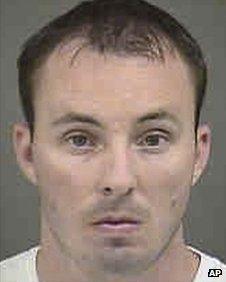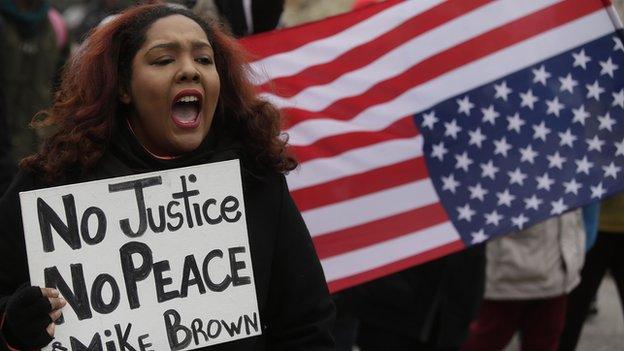The cases where US police have faced killing charges
- Published

A white South Carolina police officer has been charged with murder after a video of him shooting a black man running away from him became public - months after previous cases of police killings saw no charges against the officer. So when have police faced charges?
In 2013, Russell Rios, 19, fled a Wal-mart in Conroe, Texas, after allegedly stealing about $50 (£32) in goods from the store.
An officer, Sgt Jason Blackwelder, responded and chased Rios on foot to a wooded area. Blackwelder left the woods, Rios did not.
Blackwelder later said in his report during a struggle Rios had choked him to the point of almost losing consciousness. Blackwelder fired his gun and killed Rios, arguing it was self-defence.
But prosecutors said evidence from the scene contradicted that account, including the fact that Rios had been shot in the back of the head.
Blackwelder was charged by a grand jury for manslaughter and making false statements. He was convicted in a jury trial.
It is one example of the rare instances where police are arrested or charged for violent incidents related to their police work.

Nationwide protests have followed a grand jury decision to not charge a police officer for the death of Michael Brown
"Everybody knows policing is violent, and [jurors] don't want to second guess those decisions," says Philip Stinson, a researcher at Bowling Green State University in Ohio and former police officer.
Juries - both grand juries and trial juries - tend to "give every possible benefit of the doubt" when it comes to police officers who have killed while on-duty, Dr Stinson says.
But the secrecy of the grand jury proceedings make it hard to know why that was.
He adds this tendency to not charge does not exist as strongly for police officers investigated for non-violent crimes, including corruption cases.
Comprehensive nationwide numbers of how many police officers kill individuals while on duty do not exist.
The FBI does record "justifiable homicides" by police officers. There were 461 such homicides in 2013, but by definition, this doesn't include the number of police charged with a crime for on-duty actions.
And reporting these statistics to the FBI is voluntary. In addition, even police agencies who report their overall crime numbers are not required to submit additional data on homicides, justified or not.
Mr Stinson's own research found 41 police officers were charged with murder or manslaughter between 2005 and 2011. In the same time period, the FBI recorded several thousand justifiable homicides.

Jonathan Ferrell was killed by a police officer after he crashed his vehicle
And the process by which police officers face charges depends on the state. Some are charged by grand juries, others are charged directly by police through arrest warrants.
In Baltimore in 2008, Police Officer Tommy Sanders was indicted for voluntary manslaughter while on duty when he shot and killed Edward Lamont Hunt.
Mr Sanders told the court Hunt had been staring at him across a car park at a shopping centre. As he was searching Hunt, the officer said Hunt assaulted him and ran off. After giving chase, Sanders told the court he saw Hunt reach for something.
Mr Sanders fired three shots, two hitting Hunt in the back.
During the trial, multiple witnesses said Hunt had never assaulted the officer, nor did he reach into his coat while running.
Ferguson decision: A timeline of events
Hunt was unarmed.
While the evidence led a grand jury to charge Hunt, he was eventually found not guilty.
But the case was slightly different than recent cases of white police officers being accused of bias in handling of black suspects - Mr Sanders himself is black.
More recently, two police officers in Albuquerque, New Mexico, have been charged with first degree murder after shooting a homeless man in the hills behind the city as he appeared to surrender, and a policeman in Alabama faces assault charges after shoving an Indian man to the ground, partially paralysing him.
And in at least one case, when prosecutors do not get an indictment, they try again.
Last September, Jonathan Ferrell, 24, a former college football player, was shot by Officer Randall Kerrick as he attempted to get help after being involved a car crash late at night in Charlotte, North Carolina.
A woman alarmed by Farrell knocking and yelling at her door at two o'clock in the morning called police.

Officer Randall Kerrick has been charged with voluntary manslaughter
By the time Mr Kerrick had arrived, Ferrell had walked away, looking for help elsewhere. What happened next is disputed, but it ended with Mr Kerrick shooting at the 24-year-old 12 times, 10 of the shots hitting Ferrell.
Mr Kerrick's own police department said the shooting was "excessive" and said he "did not have a lawful right to discharge his weapon" during the incident.
Prosecutors brought the case to a grand jury, and when they did not charge Kerrick, the state argued the jury had not had enough people and convened a second grand jury, which did indict.
Mr Kerrick faces trial for manslaughter next year.
And once a case goes to court, and even a conviction, the tendency to give police officers every benefit appears to extend to the sentencing as well.
After his conviction, Blackwelder was given five years probation for the crime. He had faced up to 20 years based on the charge.
Additional reporting by Micah Luxen
- Published4 December 2014

- Published2 December 2014

- Published10 August 2015
